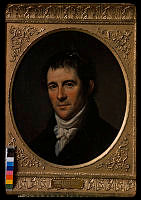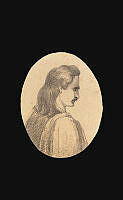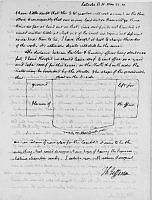A Neighbor Returns More Than a Cup of Sugar
Copyright © Fall 2009 White House Historical Association. All rights reserved under international copyright conventions. No part of this article may be reproduced or utilized in any form or by any means, electronic or mechanical, including photocopying, recording, or by any information storage and retrieval system, without permission in writing from the publisher. Requests for reprint permissions should be addressed to books@whha.org
In 2009, White House neighbors on Lafayette Square shared a fascinating surprise. In October 2008, Decatur House, an historic property of the National Trust for Historic Preservation, located in its storage a painting that had been purchased for the White House in 1890. The removal of the painting from the White House in the early twentieth century is undocumented, but its return is the neighborly action to which we here call attention as a prelude to the next issue of White House History on the White House neighborhood.
Prior to 1961, when First Lady Jacqueline Kennedy added a formal museum component to the complex operations of the White House, the fine arts in the White House was almost exclusively portraiture: presidents portraits were purchased by the government, and first ladies (all but one Martha Washington) were received as donations from nonfederal sources. Back in 1890, however, First Lady Caroline Harrison, founder of the famous White House china collection, acquired two watercolor landscapes of the American seaside, one of the Atlantic shore and the other of the Pacific.

The Beach from the Cliff-House near San Francisco, California painted in 1886 by Peter Petersen Toft.
White House Collection/White House Historical AssociationFrom the East came A Summer Day at Saulsbury [sic, Salisbury] Beach, a Massachusetts scene painted in 1889 by James Henry Moser (18541913), a member of the Washington (D.C.) Watercolor Club, who had collaborated with Frederic S. Church in 1880 on the illustrations for the first edition of Uncle Remus by Joel Chandler Harris. From the West came The Beach from the Cliff House near San Francisco, California painted in 1886 by Peter Petersen Toft (18251901), a Danish-born artist who arrived in San Francisco in 1850 for the gold rush but soon turned to painting in the Pacific Northwest. Colonel O. H. Ernst of the Office of Public Buildings and Grounds, wrote to the artist in London on July 7, 1890:
At the request of Mrs. Harrison, I have obtained for the Executive Mansion from Mrs. [Phoebe] Hearst, the water color The Beach from the Cliff-House near San Francisco, California, and enclose herewith vouchers covering the price of same. Please sign both vouchers at lower right-hand corner under receipt, and return them to this office, when the amount will be remitted in such manner as you may indicate.1

The Beach from the Cliff-House is seen hanging above the piano in the West Sitting Hall on the Second Floor of the White House in 1890.
Phoebe Hearst's husband George, a mining baron from San Francisco and one of the wealthiest men in America, was elected to the U.S. Senate from California in 1887. The couple lived in Washington until his death in 1891. Their only son was the famous newspaper magnate and collector William Randolph Hearst. The price for the Toft was not mentioned, but one could presume that it was comparable to the $25 believed spent by the government for the Moser.2
The two watercolors were framed to match and hung in the West Sitting Hall on the Second Floor, the sitting area in the family quarters at the top of the large staircase from the State Floor. In that space they joined three of five Western works placed in the White House by the famous American artist Albert Bierstadt in 1882. (Never able to persuade the federal government to buy them for a negotiated price of $50,000, Bierstadt lost title to the works in an 1895 bankruptcy sale; their removal from the White House before about 1897, however, is not documented.)
By 1900, the two watercolors had been moved to the Library, the oval room on the Second Floor, but their history gets very fuzzy in the early twentieth century. In the inventories each was listed as only water color, marine scene, and neither shows in the photographs of Second Floor rooms in the period. In 1913 they were removed to storage, probably the result of the installation throughout the Second Floor of paintings executed by First Lady Ellen Wilson (who died in the White House in 1914). In 1921, after the departure of President Wilson and his second wife, Edith, two works listed as Painting, marine were moved back out of storage, but the Toft was not one of them.
Scroll forward to August 2008, when Decatur House staff found in their collections storage a portion of a backboard bearing a brass label reading:
The Beach from the Cliff House / near San Francisco, Cal. / a watercolor painted in 1886 by / P. Toft / purchased from the artist by the government / and placed in the Executive Mansion in / July 1890

This photograph, taken in the Library (now the Yellow Oval Room) c. 1900, led to the discovery of the painting and its original frame in the Decatur House collection in 2008.
The best photograph of the Toft painting in its original frame, taken c. 1900, supplied by the White House curator William Allman to Cindi Malinick, director of the Decatur House, led to the discovery of the actual painting and its 1890s frame. Since neither was part of the Decatur House accessioned collection, Malinick arranged with the National Trust for Historic Preservation for the return of the painting and frame to the White House.
Neither Decatur House nor the National Trust have any record of how the watercolor came into their hands. Malinick originally wondered if the friendship between Alice Roosevelt Longworth, President Theodore Roosevelts eldest child, and Marie Beale, of the California family that bequeathed Decatur House to the National Trust, may have led to the placement of this California scene at Decatur House during the Roosevelt administration. Another theory focused on the concentration in the Decatur House collection dating from the Beale familys ownership of other representations of the Golden State, including the seal of California inlaid into an elaborate wood floor in its grand second floor dining room, a silver service adorned with California bears, and two oil paintings of the ill-fated Camel Corps in the California desert by Erneste Etienne Narjot.
Perhaps a more plausible possibility is that the Toft was removed from the White House by mistake in 1921 when Ellen Wilsons paintings left among the personal property of President Woodrow Wilson. The Woodrow Wilson House on S Street and Decatur House were among the first properties designated as National Trust Historic Sites, and were, until the 1980s, even administered jointly as the Washington Properties. During this period, which was well before the carefully adhered-to accession standards of today, the collections of the two sites well might have been intermingled or the Toft painting simply could have been placed in Decatur House once staff determined it was not a proper Wilson possession. That hypothesis, however, is also undocumented.
The White House is most pleased to have the Peter Toft painting back in its original home. The full journey of The Beach from the Cliff House may never be known, but its return to the White House collection is a reminder of the Executive Mansions close, and sometimes surprising ties to its Lafayette Square neighborhood.






























































